Market Share
Latin America Ancillary Services Market Share Analysis
The Latin America Ancillary Services Market, encompassing a wide range of supplementary offerings beyond core products or services, presents a fertile ground for companies to strategically position themselves and capture market share. One prevalent strategy in this market is the diversification of ancillary services. Companies operating in Latin America recognize the importance of catering to diverse consumer needs and preferences, hence they expand their portfolio to include a variety of ancillary services such as insurance, car rentals, hotel bookings, and entertainment options. By offering a comprehensive suite of services, companies can appeal to a broader customer base, enhance customer satisfaction, and ultimately gain a competitive edge in the market.
Branding and reputation management play a pivotal role in market share positioning within the Latin America Ancillary Services Market. Establishing a strong brand identity and reputation for reliability, quality, and customer service is essential for attracting and retaining customers. Companies that are perceived as trustworthy and customer-centric are more likely to win the trust and loyalty of consumers, driving repeat business and referrals. Through effective branding and reputation management strategies, companies can differentiate themselves from competitors and solidify their position in the market.
Price positioning is another critical aspect of market share positioning in the Latin America Ancillary Services Market. While offering value-added services is important, companies must also strike the right balance between affordability and profitability. Pricing strategies such as bundling, tiered pricing, and dynamic pricing enable companies to cater to different customer segments and market conditions while maximizing revenue opportunities. Moreover, transparent pricing policies and promotional offers help create a perception of value for money, attracting price-conscious consumers and increasing market share.
Distribution and channel management are fundamental components of market share positioning in the Latin America Ancillary Services Market. Companies leverage various distribution channels, including online platforms, travel agencies, mobile apps, and partnership networks, to reach customers effectively. By optimizing distribution channels and enhancing accessibility, companies can expand their market reach, streamline the booking process, and capitalize on emerging opportunities in the digital landscape. Additionally, strategic partnerships with airlines, hotels, and other travel-related businesses facilitate cross-selling and upselling of ancillary services, further strengthening market position.
Strategic partnerships and collaborations are instrumental in gaining market share in the Latin America Ancillary Services Market. Companies often collaborate with other industry players, technology providers, and local businesses to enhance their service offerings, improve customer experience, and access new market segments. Whether it's integrating services with third-party platforms, co-branding initiatives, or joint marketing campaigns, partnerships create synergies that drive growth and competitive advantage. Moreover, alliances with financial institutions, loyalty programs, and corporate clients enable companies to unlock additional revenue streams and solidify their market position.
Continuous innovation and adaptation are essential for maintaining market share in the dynamic Latin America Ancillary Services Market. Companies must stay abreast of changing consumer preferences, market trends, and technological advancements to remain competitive. Investing in research and development, leveraging data analytics, and embracing emerging technologies such as artificial intelligence and blockchain enable companies to enhance service offerings, personalize customer experiences, and stay ahead of the curve. By demonstrating agility and innovation, companies can effectively position themselves in the market and sustain long-term growth and profitability.






Leave a Comment